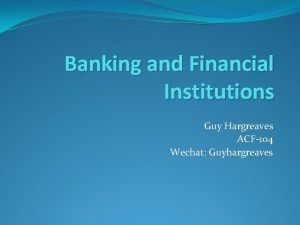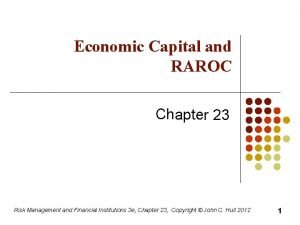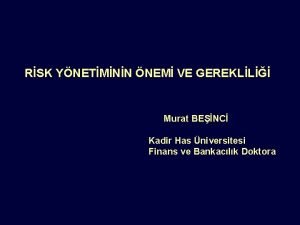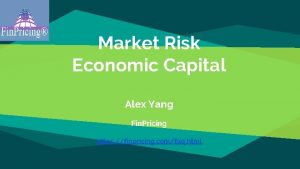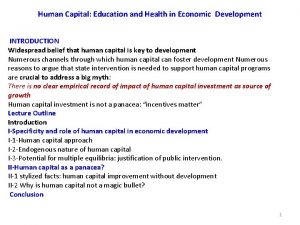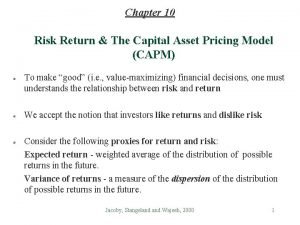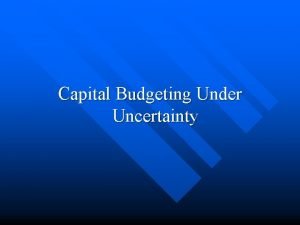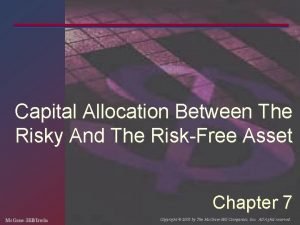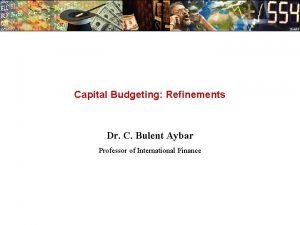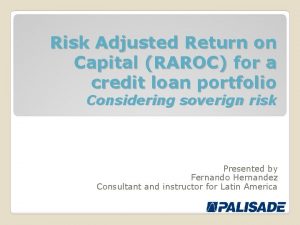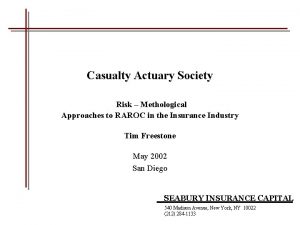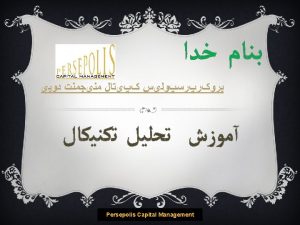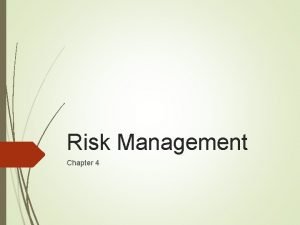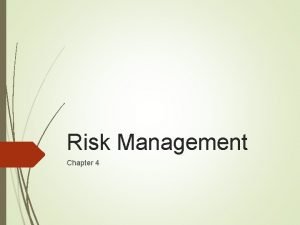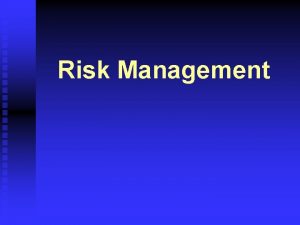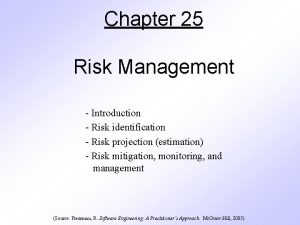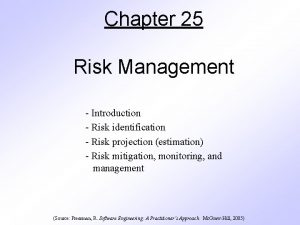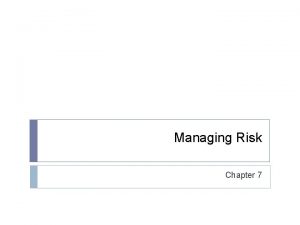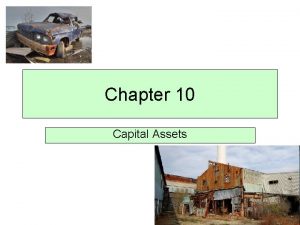Economic Capital and RAROC Chapter 23 Risk Management
























- Slides: 24

Economic Capital and RAROC Chapter 23 Risk Management and Financial Institutions 3 e, Chapter 23, Copyright © John C. Hull 2012 1

Economic Capital l A bank’s own assessment of the capital it requires Risk Management and Financial Institutions 3 e, Chapter 23, Copyright © John C. Hull 2012 2

Model Used for Economic and Capital (Same as Regulatory Capital) Figure 23. 1, page 492 Expected Loss X% Worst Case Loss Capital Loss over time horizon Risk Management and Financial Institutions 3 e, Chapter 23, Copyright © John C. Hull 2012 3

Choice of Parameters l l For a bank wishing to maintain a AArating, capital is chosen so that X is about 99. 95% and time horizon is one year This is because statistics from rating agencies show that an AA-rated company should have a probability of only about 0. 05% of defaulting in one year Risk Management and Financial Institutions 3 e, Chapter 23, Copyright © John C. Hull 2012 4

The Basel II Regulatory Environment (Figure 23. 2, page 493) Total Risk Non-Business Risk (regulatory capital): Business Risk (no regulatory capital): Credit Risk Market Risk Operational Risk from Strategic Decisions Reputation Risk Management and Financial Institutions 3 e, Chapter 23, Copyright © John C. Hull 2012 5

One-year Market Risk Gains/Loss Distribution (Figure 23. 3, page 496) Gain Loss Risk Management and Financial Institutions 3 e, Chapter 23, Copyright © John C. Hull 2012 6

One-year Credit Risk Loss Distribution (Figure 23. 4, page 496) Loss Risk Management and Financial Institutions 3 e, Chapter 23, Copyright © John C. Hull 2012 7

One Year Operational Risk Loss Distribution (Figure 23. 5, page 496) Loss Risk Management and Financial Institutions 3 e, Chapter 23, Copyright © John C. Hull 2012 8

Characteristics of Distributions (Table 23. 1, page 497) Second Moment (Variance) Market Risk High Third Moment (Skewness) Zero Fourth Moment (Kurtosis) Low Credit Risk Moderate Operational Risk Low High Risk Management and Financial Institutions 3 e, Chapter 23, Copyright © John C. Hull 2012 9

Importance of Risks (page 497) Type of Business Most Important Risk Commercial Credit Risk Banking Investment Market Risk and Banking & Trading Credit Risk Asset Management Operational Risk Management and Financial Institutions 3 e, Chapter 23, Copyright © John C. Hull 2012 10

European Growth Trust (Example of Operational Risk in Asset Management) See Business Snapshot 23. 1 l l l No more than 10% of EGT could be invested in unlisted securities Peter Young the fund manager violated this rule The cost to Deutsche Bank was about $200 million Risk Management and Financial Institutions 3 e, Chapter 23, Copyright © John C. Hull 2012 11

Interactions of Risks Credit Risk LGD and PD depend on market value Market Risk Operational risks can be contingent on market moves or credit events Operational Risk Management and Financial Institutions 3 e, Chapter 23, Copyright © John C. Hull 2012 12

Integrated Risk Management Typically a bank calculates economic capital for different types of risk and different units l It is then faced with the problem of aggregating the risks l Risk Management and Financial Institutions 3 e, Chapter 23, Copyright © John C. Hull 2012 13

Combining the Distributions l l l Assume perfect correlation: overstates capital by about 40% Assume distributions are normal for the purposes of aggregation: understates capital by about 40% Hybrid approach: seems to work reasonable well Risk Management and Financial Institutions 3 e, Chapter 23, Copyright © John C. Hull 2012 14

Example: Economic Capital Estimates (Table 23. 2, page 500) Market Risk Business Unit 1 30 Business Unit 2 40 Credit Risk 70 80 Operational Risk 30 90 Risk Management and Financial Institutions 3 e, Chapter 23, Copyright © John C. Hull 2012 15

Correlations l l l Market and credit risk within the same business unit: 0. 5 Market and operational risk or credit and operational risk within the same business unit: 0. 2 Market risks across business units: 0. 4 Credit risk across business units: 0. 6 Operational risk across business units: 0. 0 Risk Management and Financial Institutions 3 e, Chapter 23, Copyright © John C. Hull 2012 16

Total Economic Capital l Business Unit 1: 100. 0 Business Unit 2: 153. 7 Whole bank: 203. 2 Diversification benefit is 253. 7 – 203. 2 = 50. 5 How should this be allocated to the business units? Equivalently how should the total economic capital of 203. 2 be allocated? Risk Management and Financial Institutions 3 e, Chapter 23, Copyright © John C. Hull 2012 17

Alternatives l l l Allocate economic capital in proportion to the stand alone economic capitals Allocate economic capital in proportion to marginal contribution of business units to total economic capital Set economic capital for business unit i equal to where xi is the size of business unit i Risk Management and Financial Institutions 3 e, Chapter 23, Copyright © John C. Hull 2012 18

Deutsche Bank Economic Capital (millions of Euros) Table 23. 4, page 503 Credit Risk 12, 785 Market Risk 13, 160 Operational Risk 3, 682 Diversification benefits (3, 534) Business Risk 1, 085 Total economic capital 27, 178 Total risk-weighted assets 346, 204 Core Tier 1 Capital (% of RWA) 8. 7% Core plus Additional Tier 1 Capital (% of RWA) 12. 3% Tier 1 plus Tier 2 capital (% of RWA) 14. 1% Risk Management and Financial Institutions 3 e, Chapter 23, Copyright © John C. Hull 2012 19

Allocation of Deutsche Bank Capital Corporate banking and securities 14, 828 Global transaction banking 1, 291 Asset and wealth management 2, 717 Private business clients 6, 677 Corporate investments 902 Consolidation and adjustments 762 Total 27, 178 Risk Management and Financial Institutions 3 e, Chapter 23, Copyright © John C. Hull 2012 20

RAROC (page 503) l l RAROC is the return on economic capital for a business unit The denominator is the economic capital allocated to the business unit The numerator is the expected profit. This can be before or after tax and can include a interest at the risk-free rate on the economic capital It is sometimes also referred to as RORAC Risk Management and Financial Institutions 3 e, Chapter 23, Copyright © John C. Hull 2012 21

Example 23. 5 (page 504) l l l When lending in a certain region of the world an AA-rated bank estimates its average losses from defaults as 1% of outstanding loans per year The 99. 9% worst case loss is 5% of outstanding loans Economic capital per $100 of loans is therefore $4 Risk Management and Financial Institutions 3 e, Chapter 23, Copyright © John C. Hull 2012 22

Example continued l The bank’s spread between cost of funds and interest charged is 2. 5% and administrative costs are 0. 7% Risk Management and Financial Institutions 3 e, Chapter 23, Copyright © John C. Hull 2012 23

Ex-ante vs Ex-post l l l RAROC was originally suggested as a tool to be used on an ex-ante basis. This means that we have to forecast the expected loss It is then used as a tool to allocate capital to the most profitable parts of the business It is also sometimes used on an ex-post basis for performance evaluation. Realized loss then replaces expected loss Risk Management and Financial Institutions 3 e, Chapter 23, Copyright © John C. Hull 2012 24
 Commercial bank products and services
Commercial bank products and services What is economic capital
What is economic capital Raroc negativo
Raroc negativo Raroc adalah
Raroc adalah Raroc nedir
Raroc nedir Basle ii
Basle ii Regulatory capital vs economic capital
Regulatory capital vs economic capital Market risk economic capital
Market risk economic capital Business risk and financial risk leverage
Business risk and financial risk leverage Liquidity measures
Liquidity measures Key risk indicators financial risk management
Key risk indicators financial risk management Risk map
Risk map What is economic growth and development
What is economic growth and development Human capital education and health in economic development
Human capital education and health in economic development Net working capital refers to which of the following
Net working capital refers to which of the following Difference between capital reserve and reserve capital
Difference between capital reserve and reserve capital Multinational capital structure
Multinational capital structure Difference between capital reserve and reserve capital
Difference between capital reserve and reserve capital Constant capital and variable capital
Constant capital and variable capital Multinational cost of capital and capital structure
Multinational cost of capital and capital structure Capital market line
Capital market line Capital budgeting under risk and uncertainty
Capital budgeting under risk and uncertainty Capital allocation line formula
Capital allocation line formula Mwacc
Mwacc Economic growth vs economic development
Economic growth vs economic development
